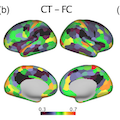Abstract
Adolescence represents a time of unparalleled brain development. In particular, developmental changes in morphometric and cytoarchitectural features are accompanied by maturation in the functional connectivity (FC). Here, we examined how three facets of the brain, including myelination, cortical thickness (CT), and resting-state FC, interact in children between the ages of 10 and 15. We investigated the pattern of coordination in these measures by computing correlation matrices for each measure as well as meta-correlations among them both at the regional and network levels. The results revealed consistently higher meta-correlations among myelin, CT, and FC in the sensory-motor cortical areas than in the association cortical areas. We also found that these meta-correlations were stable and little affected by age-related changes in each measure. In addition, regional variations in the meta-correlations were consistent with the previously identified gradient in the FC and therefore reflected the hierarchy of cortical information processing, and this relationship persists in the adult brain. These results demonstrate that heterogeneity in FC among multiple cortical areas are closely coordinated with the development of cortical myelination and thickness during adolescence.
